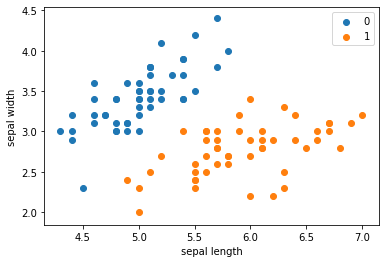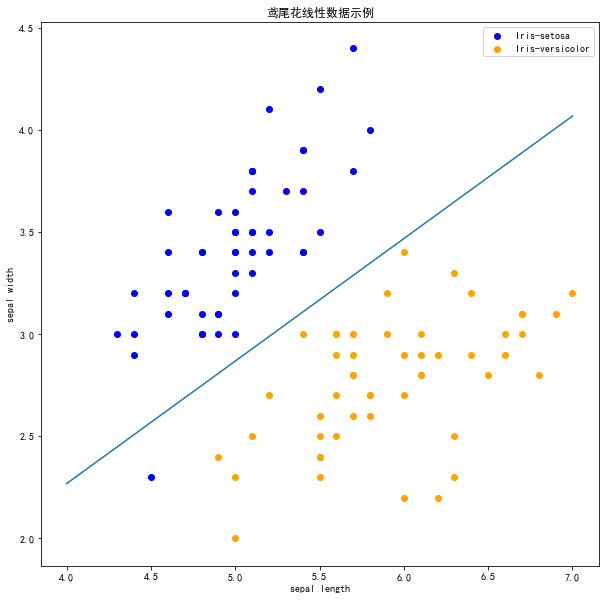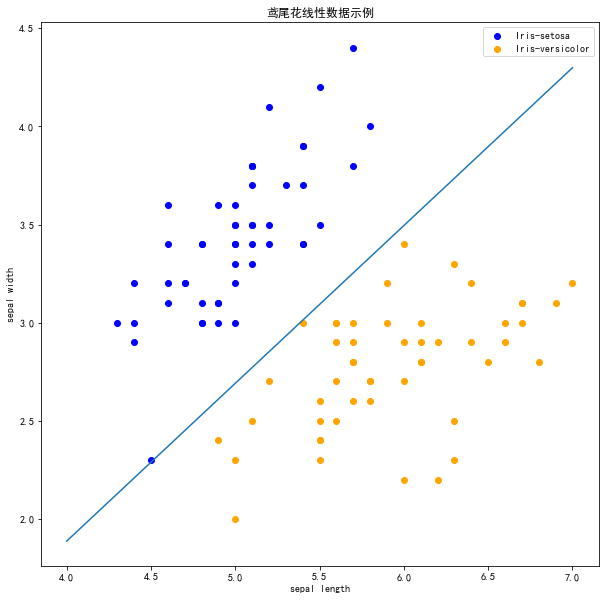实验一 感知器及其应用
【实验目的】
- 理解感知器算法原理,能实现感知器算法;
- 掌握机器学习算法的度量指标;
- 掌握最小二乘法进行参数估计基本原理;
- 针对特定应用场景及数据,能构建感知器模型并进行预测。
【实验内容】
- 安装Pycharm,注册学生版。
- 安装常见的机器学习库,如Scipy、Numpy、Pandas、Matplotlib,sklearn等。
- 编程实现感知器算法。
- 熟悉iris数据集,并能使用感知器算法对该数据集构建模型并应用。
【感知机定义】
1.感知机是根据输入实例的特征向量\(x\)对其进行二类分类的线性分类模型:
感知机模型对应于输入空间(特征空间)中的分离超平面\(w \cdot x+b=0\)。
2.感知机学习的策略是极小化损失函数:
损失函数对应于误分类点到分离超平面的总距离。
3.感知机学习算法是基于随机梯度下降法的对损失函数的最优化算法,有原始形式和对偶形式。算法简单且易于实现。原始形式中,首先任意选取一个超平面,然后用梯度下降法不断极小化目标函数。在这个过程中一次随机选取一个误分类点使其梯度下降。
4.当训练数据集线性可分时,感知机学习算法是收敛的。感知机算法在训练数据集上的误分类次数\(k\)满足不等式:
当训练数据集线性可分时,感知机学习算法存在无穷多个解,其解由于不同的初值或不同的迭代顺序而可能有所不同。
【二分类模型基本实现】
\(f(x) = sign(w\cdot x + b)\)
\(\operatorname{sign}(x)=\left\{\begin{array}{ll}{+1,} & {x \geqslant 0} \\ {-1,} & {x<0}\end{array}\right.\)
给定训练集:
\(T=\left\{\left(x_{1}, y_{1}\right),\left(x_{2}, y_{2}\right), \cdots,\left(x_{N}, y_{N}\right)\right\}\)
定义感知机的损失函数
\(L(w, b)=-\sum_{x_{i} \in M} y_{i}\left(w \cdot x_{i}+b\right)\)
随即梯度下降法 Stochastic Gradient Descent
随机抽取一个误分类点使其梯度下降。
\(w = w + \eta y_{i}x_{i}\)
\(b = b + \eta y_{i}\)
当实例点被误分类,即位于分离超平面的错误侧,则调整\(w\), \(b\)的值,使分离超平面向该无分类点的一侧移动,直至误分类点被正确分类
拿出iris数据集中两个分类的数据和[sepal length,sepal width]作为特征
import pandas as pd
import numpy as np
from sklearn.datasets import load_iris
import matplotlib.pyplot as plt
%matplotlib inline
# load data
iris = load_iris()
df = pd.DataFrame(iris.data, columns=iris.feature_names)
df['label'] = iris.target
df.columns = [
'sepal length', 'sepal width', 'petal length', 'petal width', 'label'
]
df.label.value_counts()
plt.scatter(df[:50]['sepal length'], df[:50]['sepal width'], label='0')
plt.scatter(df[50:100]['sepal length'], df[50:100]['sepal width'], label='1')
plt.xlabel('sepal length')
plt.ylabel('sepal width')
plt.legend()

data = np.array(df.iloc[:100, [0, 1, -1]])
X, y = data[:,:-1], data[:,-1]
y = np.array([1 if i == 1 else -1 for i in y])
# 数据线性可分,二分类数据
# 此处为一元一次线性方程
class Model:
def __init__(self):
self.w = np.ones(len(data[0]) - 1, dtype=np.float32)
self.b = 0
self.l_rate = 0.1
# self.data = data
def sign(self, x, w, b):
y = np.dot(x, w) + b
return y
# 随机梯度下降法
def fit(self, X_train, y_train):
is_wrong = False
while not is_wrong:
wrong_count = 0
for d in range(len(X_train)):
X = X_train[d]
y = y_train[d]
if y * self.sign(X, self.w, self.b) <= 0:
self.w = self.w + self.l_rate * np.dot(y, X)
self.b = self.b + self.l_rate * y
wrong_count += 1
if wrong_count == 0:
is_wrong = True
return 'Perceptron Model!'
def score(self):
pass
perceptron = Model()
perceptron.fit(X, y)
x_points = np.linspace(4, 7, 10)
y_ = -(perceptron.w[0] * x_points + perceptron.b) / perceptron.w[1]
plt.plot(x_points, y_)
plt.plot(data[:50, 0], data[:50, 1], 'bo', color='blue', label='0')
plt.plot(data[50:100, 0], data[50:100, 1], 'bo', color='orange', label='1')
plt.xlabel('sepal length')
plt.ylabel('sepal width')
plt.legend()

scikit-learn实现
import sklearn
from sklearn.linear_model import Perceptron
clf = Perceptron(fit_intercept=True,
max_iter=1000,
shuffle=True)
clf.fit(X, y)
# Weights assigned to the features.
print(clf.coef_)
# 截距 Constants in decision function.
print(clf.intercept_)
# 画布大小
plt.figure(figsize=(10,10))
# 中文标题
plt.rcParams['font.sans-serif']=['SimHei']
plt.rcParams['axes.unicode_minus'] = False
plt.title('鸢尾花线性数据示例')
plt.scatter(data[:50, 0], data[:50, 1], c='b', label='Iris-setosa',)
plt.scatter(data[50:100, 0], data[50:100, 1], c='orange', label='Iris-versicolor')
# 画感知机的线
x_ponits = np.arange(4, 8)
y_ = -(clf.coef_[0][0]*x_ponits + clf.intercept_)/clf.coef_[0][1]
plt.plot(x_ponits, y_)
# 其他部分
plt.legend() # 显示图例
plt.grid(False) # 不显示网格
plt.xlabel('sepal length')
plt.ylabel('sepal width')
plt.legend()

tol 参数规定了如果本次迭代的损失和上次迭代的损失之差小于一个特定值时,停止迭代。所以我们需要设置 tol=None 使之可以继续迭代:
clf = Perceptron(fit_intercept=True,
max_iter=1000,
tol=None,
shuffle=True)
clf.fit(X, y)
# 画布大小
plt.figure(figsize=(10,10))
# 中文标题
plt.rcParams['font.sans-serif']=['SimHei']
plt.rcParams['axes.unicode_minus'] = False
plt.title('鸢尾花线性数据示例')
plt.scatter(data[:50, 0], data[:50, 1], c='b', label='Iris-setosa',)
plt.scatter(data[50:100, 0], data[50:100, 1], c='orange', label='Iris-versicolor')
# 画感知机的线
x_ponits = np.arange(4, 8)
y_ = -(clf.coef_[0][0]*x_ponits + clf.intercept_)/clf.coef_[0][1]
plt.plot(x_ponits, y_)
# 其他部分
plt.legend() # 显示图例
plt.grid(False) # 不显示网格
plt.xlabel('sepal length')
plt.ylabel('sepal width')
plt.legend()

【实验小结】
我理解了感知器算法及其原理基本实现感知器算法。并掌握机器学习算法的度量指标。了解最小二乘法进行参数估计基本原理。针对特定应用场景及数据,能构建感知器模型并进行预测。
